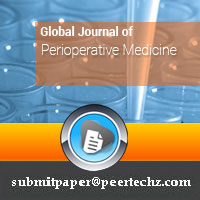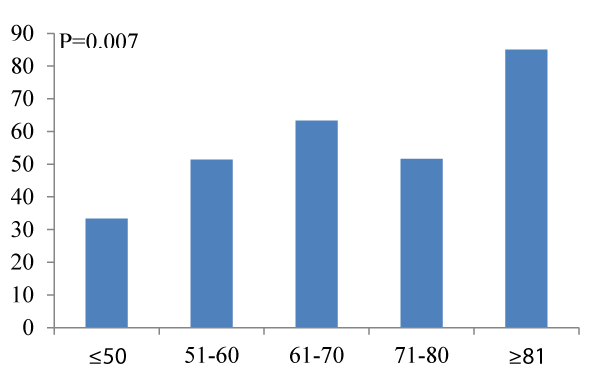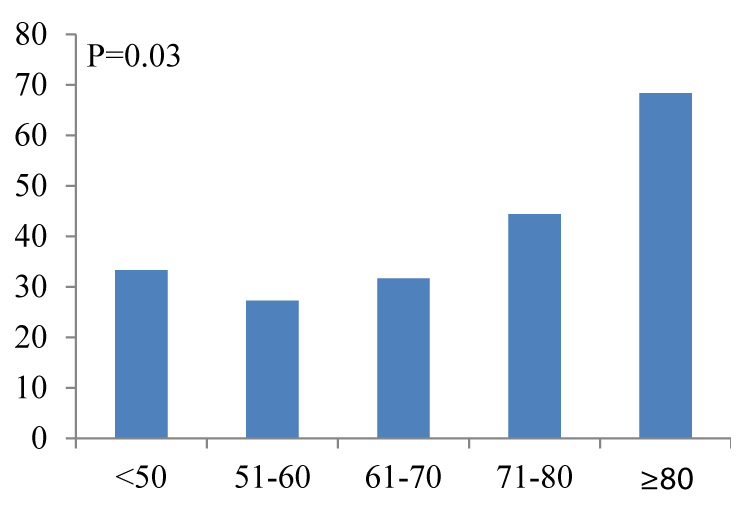Global Journal of Perioperative Medicine
Development and Implementation of a Tool to Assess Patient-Reported Outcome Measures (PROM) in Preoperative Setting
Sunghye Kim1,2, Pamela W Duncan2,3*, Leanne Groban2,4, Hannah Segal5, Rica Moonyeen Abbott3 and Jeff D Williamson1,2
2Sticht Center on Aging, Wake Forest School of Medicine, Winston Salem, NC, USA
3Department of Neurology, Wake Forest School of Medicine, Winston-Salem, NC, USA
4Department of Anesthesiology, Wake Forest School of Medicine, Winston-Salem, NC, USA
5Fisher Center for Hereditary Cancer and Clinical Genomics Research, Georgetown University, Washington, DC, USA
Cite this as
Kim S, Duncan PW, Groban L, Segal H, Abbott RM, et al. (2017) Development and Implementation of a Tool to Assess Patient-Reported Outcome Measures (PROM) in Preoperative Setting. Glob J Perioperative Med 1(1): 017-021. DOI: 10.17352/gjpm.000005Introduction: Traditional preoperative assessment tools use patients’ comorbidities to predict surgical outcomes, however, some functional, social and behavioral factors are known to predict surgical outcomes. Capturing functional, social and behavioral factors by incorporating patient reported measures (PROMs) into preoperative practice may be responsive to perioperative management and contribute to improved outcomes.
Methods: We developed a preoperative PROM tool to identify functional, social, and behavioral factors. We describe the development and implementation of the tool as a health system quality initiative. We also report the results of the PROMs among preoperative surgical patients.
Results: In our survey of 162 patients with mean age of 65, 53% were female, 29% were undergoing orthopedic surgery 12% were undergoing urologic surgery. 56% of the patients had at least one or more deficits in social or functional domain. The most common deficit was with ADLs with higher rate of deficit with advanced age.
Conclusion: Implementation of a systematic assessment of functional and social determinants to improve processes of care in the preoperative setting is feasible. The majority of preoperative patients had at least one deficit and if identified preoperatively, appropriate interventions can be offered through well-designed intervention algorithms.
Introduction
The US population is aging. While the individuals aged 65 and over made up only 11.2% of the US population in year 1980, it increased to 13% in year 2010 and it is expected to grow to 20.4% by year 2040 [1]. US healthcare systems observe the effect of this changing demographics of US population: patients who are ≥ 65 made up 38% of hospital discharges and 33% of all ambulatory surgeries in 2010 [2]. Advanced age is associated with increased postoperative complication, mortality, and functional status [3,4]. Traditional preoperative assessment tools use patients’ comorbidities [5,6], to predict surgical outcomes, however, some functional, social and behavioral factors are known to predict surgical outcomes [7-14], as well. Currently these factors are not usually collected in preoperative setting while some of the risk factors can be remediated preoperatively. Multiple survey questionnaires can be used to capture this information; however, a systematic approach might provide more effective and efficient way to obtain the information in preoperative setting. Patient Reported Outcome Measures (PROMs) are defined as any report of the status of a patient’s health condition that comes directly from the patient, without interpretation by a clinician or anyone else [15]. PROMs have been used to guide patient-centered care, clinical decision making, and health policy rulings, and are also an important tool for learning healthcare systems. PROMs improve communication between patient and providers as well as patient satisfaction [16,17] and they are well accepted by patients and clinicians [18]. PROMs may be used to improve perioperative care, by detecting preoperative deficits of patients as well as tracking postoperative trajectories. We describe the development of a preoperative PROM collection tool to identify the functional, social, and behavioral factors. We also report on the results of health system quality initiative of incorporating the PROMs tool into preoperative assessment clinic.
Methods
Development of wake forest baptist health surgical pre-screen for optimal personalized care© (wfps), a tool for optimizing post surgery recovery
Based on literature review of the social and functional determinants and the utilization of PROMs, we identified 12 domains of social and functional factors and 1-4 questions for each domain that affect patients’ ability to self-management after discharge for optimal independence, health, and recovery (Table 1). With these domains, a health services researcher and physical therapist assembled and led an interdisciplinary team of clinicians (internist with geriatric experience, physical therapists, nurses, care coordinators, surgical service line leaders and health system leaders) to implement a PROM specifically developed to screen patients preoperatively. This PROMs tool, Surgical Pre-Screen for Optimal Personalized Care© was developed for use on an iPad- and linked to a web-based patient data collection platform (Tonic Health (tonicforhealth.com)).
The responses from the electronic assessment were available in real-time to generate a PDF report to the provider, care coordinators and patients. Reports included recommendations for postoperative care and discharge as well as alerts for significant risks that posed challenges for postoperative care management linked to algorithms (Table 2), for triggering needed services. We developed algorithms to generate recommendations for interventions as well as flag factors (e.g., challenges with medication management, i.e., skilled nursing facility) that could prolong recovery or contribute to poor outcomes. The algorithms identified impairments in a single domain (e.g. medication management) or they could also be combined throughout several of the domains of health to create a referral or identify community resources to meet the specific needs of the individual. For example the “Cognition,” “ADL “Social Support” and “Physical activity/Safe mobility’ deficits could accumulate or interact to create a recommendation for considering Skilled Nursing Facility or Assisted Living Placement for post-surgical recovery. The PROMs assessment tool was interviewer administered by a research assistant in the preoperative assessment clinic at Wake Forest Medical Center. The purpose of this implementation was to characterize the challenges that our patients may have, and to collaborate with care coordination to assess if PROMs implemented in our clinical setting would identify services preoperatively that the patient may need at hospital discharge to facilitate optimal recovery and independence, as well as to reduce readmissions and length of stay.
Implementation of the tool in the preoperative assessment clinic
In the context of ongoing clinical care we used a convenience sample of 162 patients to administer the screening and assessments. Prospective participants were approached in the waiting room of the Preoperative Assessment Clinic, which serves >70 patients per day. We excluded those scheduled for emergency surgery. Once the primary visit and vital signs are completed by a clinic staff, a trained assistant interviewed the patient. The assistant interviewed all patients included in the study prior to their encounters with providers. Any deficiency with any of the questions in the short version would trigger the long version. The length of the interviews varied depending on the version: the short version took 3 minutes while long form took ten minutes on average. Following the assessment, the assistant filled out a “referrals recommended” page and informed the provider of any major concerns discovered during the interview. The assistant then met with a care coordinator to discuss the results from the questionnaire and the possible resources or referrals the patient may need. The coordinator would speak to the patient regarding possible referrals. A note was put into the patient’s electronic record of the visit if the coordinator cannot speak to the patient prior to the provider’s visit. The PROM interview did not delay the visit.
Statistical analysis
Patients’ demographic variables, scheduled surgery, deficit in each domain were expressed as mean ±SD, or percentages as appropriate. Percentages of deficit by age category (≤50, 51-60, 61-70, 71-80, ≥81) were compared using Chi-Square tests. All statistical analyses were done with STATA/IC 14 (College Station, TX) and a 2-tailed test with p<0.05 was considered statistically significant.Results
Table 3 demonstrates characteristics and deficits of 162 enrolled patients. 67% of enrolled patients had at least one deficit. Among all the enrolled patients, the most common deficit was with ADL. Out of 91 patients who completed the long form that was triggered by any deficit in the short form, the most common deficit was fall risk.
Figures 1,2 demonstrates the proportion of patients with deficits with any deficits or deficit in ADL per age group. The proportion of patients with any deficit or deficit in ADL deficit was higher with advanced age.
Discussion
Patients can provide critical information that can affect the postoperative outcomes and also can be intervened prior to surgery. Based on reviews of the social and functional determinants of surgical outcomes, we developed the Surgical Pre-Screen for Optimal Personalized Care©. This PROM assessed the major factors that could influence postoperative recovery, health and independence. Integration of the PROM data and well-designed electronic algorithms were used to identify and facilitate perioperative and post-discharge care needs in real time. In this quality improvement initiative, we demonstrated that if identified preoperatively, appropriate interventions can be offered through intervention algorithms. We also demonstrated that the implementation of the tool is feasible in the clinical workflow of a preoperative clinic setting. Preoperative PROMs have been developed and tested in certain surgery population [19-21]. However, most of the studies conducted the study in patients who are undergoing specific surgeries and assessed PROM in specific areas that the surgery will have impact (e.g., joint symptoms for joint replacement surgery). Our study enrolled patients who were undergoing various surgeries, including orthopedic, urologic, general, cardiothoracic, ophthalmologic, neurosurgery, breast or endocrine and endoscopic surgeries. We assessed preoperative their functional, social and behavioral factors and identified areas that the patients had deficits in. We found that more than half of the patients that we obtained PROMs had deficits in one or more domains. We did not find any association between the planned surgeries and deficits. The limitations of our study include the relatively small size of the sample and generalizability of the findings. We also did not measure surgical outcomes with this quality improvement project. Given the pilot nature of the study, we are planning on subsequent study that explore the surgical outcomes and correlate the outcomes with preoperative PROMs. We did not provide the opportunity for the patients to give us the feedback on the tool. With further study, we will incorporate patients’ feedback on the tool to improve the user friendliness and effectiveness of the tool.
Conclusion
Efficient and effective assessment of the social and behavioral determinants of health, comprehensive assessment of functional status, health literacy, patient’s perception of health, and preferences for self-management may improve the success of postoperative management of vulnerable patients undergoing surgery and the Institute of Medicine recommended social and behavioral factors be incorporated into electronic health records as a pathway to improving care quality and safety (EHRs) [22]. In this quality improvement initiative, we demonstrated that if identified preoperatively, appropriate interventions can be offered through well-designed intervention algorithms. The implementation of the tool is feasible in the clinical workflow of a preoperative clinic setting.
This work was partially supported by the National Institute on Aging (1R03AG050919 – 01) and the Wake Forest University Claude D. Pepper Older Americans Independence Center (P30-AG21332).
- Jacobsen LA, Kent M, Lee M, Mather M (2011) America's Aging population. Population Reference Bureau; 2011 [cited 2017 May 5th]. Link: https://goo.gl/GGBV5C
- Hall MJ, Schwartzman A, Zhang J, Liu X (2017) Ambulatory Surgery Data From Hospitals and Ambulatory Surgery Centers: United States, 2010. National health statistics reports 2017: 1-15. Link: https://goo.gl/n1pbeN
- Massarweh NN, Legner VJ, Symons RG, McCormick WC, Flum DR (2009) Impact of advancing age on abdominal surgical outcomes. Arch Surg 144: 1108-1114. Link: https://goo.gl/sSzKox
- Gajdos C, Kile D, Hawn MT, Finlayson E, Henderson WG, et al. (2013) Advancing age and 30-day adverse outcomes after nonemergent general surgeries. Journal of the American Geriatrics Society 61: 1608-1614. Link: https://goo.gl/wXmEfm
- Fleisher LA, Fleischmann KE, Auerbach AD, Barnason SA, Beckman JA, et al. (2014) 2014 ACC/AHA guideline on perioperative cardiovascular evaluation and management of patients undergoing noncardiac surgery: a report of the American College of Cardiology/American Heart Association Task Force on practice guidelines. Journal of the American College of Cardiology 64: e77-137. Link: https://goo.gl/wkd9dq
- Qaseem T (2006) Risk assessment for and strategies to reduce perioperative pulmonary complications. Annals of internal medicine 145: 553. Link: https://goo.gl/PGejYB
- Leung JM, Sands LP, Mullen EA, Wang Y, Vaurio L (2005) Are preoperative depressive symptoms associated with postoperative delirium in geriatric surgical patients? The journals of gerontology Series A 60: 1563-1568. Link: https://goo.gl/VBHb1A
- Hole DJ, McArdle CS (2002) Impact of socioeconomic deprivation on outcome after surgery for colorectal cancer. The British journal of surgery 89: 586-590. Link: https://goo.gl/2DKrMn
- Jeevan R, Browne JP, Pereira J, Caddy CM, Sheppard C, et al. (2015) Socioeconomic deprivation and inpatient complication rates following mastectomy and breast reconstruction surgery. The British journal of surgery 102: 1064-1070. Link: https://goo.gl/tU84mK
- Mathews R, Peterson ED, Honeycutt E, Chin CT, Effron MB, et al. (2015) Early Medication Nonadherence After Acute Myocardial Infarction: Insights into Actionable Opportunities From the Treatment with ADP receptor Inhibitors: Longitudinal Assessment of Treatment Patterns and Events After Acute Coronary Syndrome Study. Circulation Cardiovascular quality and outcomes 8:347-356. Link: https://goo.gl/ZCYmiq
- Locher JL, Bonner JA, Carroll WR, Caudell JJ, Allison JJ, et al. (2013) Patterns of prophylactic gastrostomy tube placement in head and neck cancer patients: a consideration of the significance of social support and practice variation. The Laryngoscope 123: 1918-1925. Link: https://goo.gl/VaxcbW
- Greenleaf EK, Cooper AB, Hollenbeak CS (2016) Marital Status and Survival in Patients with Carcinoid Tumors. Health services insights 9: 3-11. Link: https://goo.gl/wzNzzY
- Costa AL, Heitkemper MM, Alencar GP, Damiani LP, Silva RM, et al. (2016) Social Support Is a Predictor of Lower Stress and Higher Quality of Life and Resilience in Brazilian Patients With Colorectal Cancer. Cancer nursing 40: 352-360. Link: https://goo.gl/ijfpUQ
- Torres OH, Munoz J, Ruiz D, Ris J, Gich I, et al. (2004) Outcome predictors of pneumonia in elderly patients: importance of functional assessment. Journal of the American Geriatrics Society 52: 1603-1609. Link: https://goo.gl/CQ9VL1
- Collaboratory NHCSR. Patient-Reported Outcomes in In Rethinking Clinical Trials: A Living Textbook of Pragmatic Clinical Trials. Link: https://goo.gl/iL1jod
- Detmar SB, Muller MJ, Schornagel JH, Wever LD, Aaronson NK (2002) Health-related quality-of-life assessments and patient-physician communication: a randomized controlled trial. JAMA 288: 3027-3034. Link: https://goo.gl/7wJFEo
- Velikova G, Booth L, Smith AB, Brown PM, Lynch P, et al. (2004) Measuring quality of life in routine oncology practice improves communication and patient well-being: a randomized controlled trial. Journal of clinical oncology: official journal of the American Society of Clinical Oncology 22: 714-724. Link: https://goo.gl/RshhTj
- Santana MJ, Feeny D, Weinkauf J, Nador R, Kapasi A, et al. (2010) The use of patient-reported outcomes becomes standard practice in the routine clinical care of lung-heart transplant patients. Patient related outcome measures 1: 93-105. Link: https://goo.gl/q1N2rA
- Keays MA, Starke N, Lee SC, Bernstein I, Snodgrass WT, et al. (2016) Patient Reported Outcomes in Preoperative and Postoperative Patients with Hypospadias. The Journal of urology 195: 1215-1220. Link: https://goo.gl/CmUhQi
- Wong SE, Zhang AL, Berliner JL, Ma CB, Feeley BT (2016) Preoperative patient-reported scores can predict postoperative outcomes after shoulder arthroplasty. Journal of shoulder and elbow surgery 25: 913-919. Link: https://goo.gl/Gp8j9X
- Bingener J, Sloan JA, Novotny PJ, Pockaj BA, Nelson H (2015) Perioperative patient-reported outcomes predict serious postoperative complications: a secondary analysis of the COST trial. Journal of gastrointestinal surgery 19: 65-71. Link: https://goo.gl/57nMR2
- Adler NE, Stead WW (2015) Patients in context--EHR capture of social and behavioral determinants of health. N Engl J Med 372: 698-701. Link: https://goo.gl/YFJmmS

Article Alerts
Subscribe to our articles alerts and stay tuned.
 This work is licensed under a Creative Commons Attribution 4.0 International License.
This work is licensed under a Creative Commons Attribution 4.0 International License.


 Save to Mendeley
Save to Mendeley
